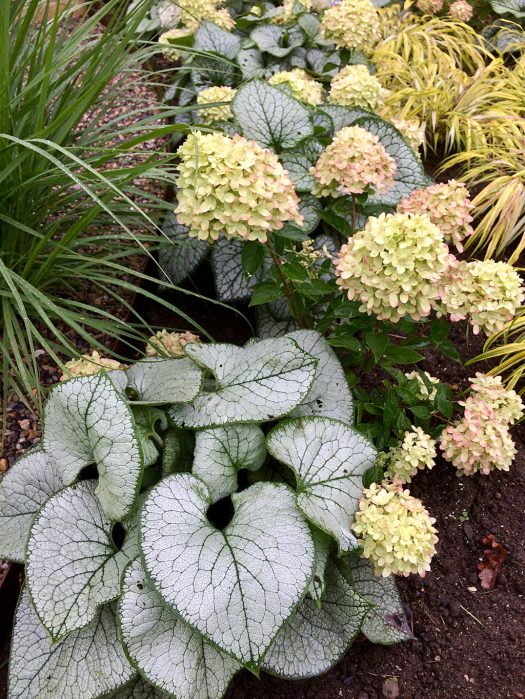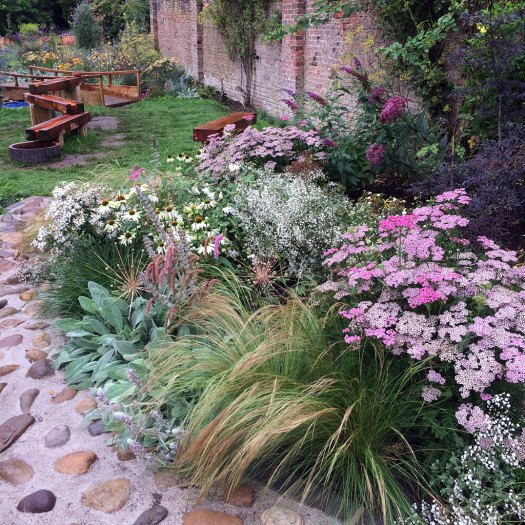
What makes a sensory garden different to any other garden? We can expect the boundaries to be pushed, as they are in Howick Hall’s new sensory garden. Starting, as in any garden, with the soothing power of green, contrasting textures and colours are layered on to stimulate us.

We respond with an instinctive head-turn as we half-spot a flash of wings between rustling leaves. Our thumbs and forefingers are stained and scented from crushing a rosemary leaf, just one of many fragrant plants around us. We tune in to sounds – water splashing, birdsong and the blunt music of windchimes.

Even the floor disrupts us with treadable creeping plants, gravel, concrete and pebbles laid underfoot in different areas to capture our attention. A circle of astroturf helps protect one high-use area and was the only bit to stay green during our last, dry summer.
Throw in as many extras as the the designer can imagine (and the garden’s owners can afford) and we have a full-blown sensory garden worth its label, designed to intensify our experience of the Great Outdoors. This one includes a circular labyrinth, carved tree snags, activity centre, treasure chest, willow dome, mirrors and a river of blue glass crossed by a wooden bridge. My favourite part? Designer Natasha McEwen’s plant combinations.

Still it can be tempting to conclude, in response to my initial question, that all gardens are sensory gardens, even the odd ones where your senses do a quick sweep and conclude “Not for me”. When I met Debie Deaton recently, I mentioned that I’d been mulling over this. She thought for a moment and agreed that a garden is always sensory – it’s more a case, she said, of whether the person is receptive and open to the sensations.

That made a lot of sense. Labelling an outdoor space as a sensory garden gives us permission to submerge ourselves in sensations rather than carry on busily by: making the most of where we are instead of looking for what’s next.

Gardeners often focus on the practical aspects of any garden we visit – “Will that plant grow in my garden?”, “Could I use that technique?”, “How on earth did they drag that stone there?”, “That’s a good use for my dead tree!”, etc. A sensory garden gives us a firm nudge in a different direction, suggesting that we make the most of the opportunity to simply see, hear, taste, smell and feel.

And, of course, most gardens the public are invited to visit are made to be enjoyed from a judicious distance. Only the gardener has full trampling rights and intimacy with all the ins and outs of the garden. The flat stones that permit access to tidy are out of bounds to the visitor, as is the the gated area around a toolshed or propagation zone. The best looking seating areas are often chained off. Devices that keep the public at bay may be deemed neccessary protections, but each “Keep out!” sign disrupts the illusion that any garden we enjoy spending time in is partly ours while we wander in it, not through deeds of ownership but in natural affinity.
In contrast, sensory gardens need us to be interactive to fulfil their mission. We have the illusion, at least, of access-all-areas passes. And so it is at Howick Hall. Tools and toys are left out to tempt us. Pinecones, layered rocks and feathers prompt us to puzzle over some of nature’s everyday mysteries. Jugs hang beside the water feature in a silent appeal to the inner child that loves to divert, collect and splash water at any age.

Shells and carvings on tree stumps add texture to texture so the best of us pause to trace out the patterns with mind or fingers. If we dart across the lawn to catch a falling leaf, or creep inside the willow dome, nobody bats an eyelid. We’re here to take part.
New in 2018, the sensory garden is beautifully planted and showed few signs of being a young garden, other than a wonderful sense of balance. It will be interesting to see how the planting develops after one or other plant has had time to hurl its weight around through seeding or spreading. I feel sure we’ll be tempted back before too long to find out.

Credits and links
Howick Hall’s Sensory Garden was made in partnership with the National Autistic Society, with funding from the National Garden Scheme. The idea was to make a safe, inclusive space that is both stimulating and calming.
It was designed by Natasha McEwen, garden maker, plantswoman and professional gardener.
One of the best ways to increase awareness of autism is to listen to what autistic people have to say about living in a neurotypical world – for example, by checking out some of the bloggers on the Actually Autistic Blogs List.

Sensory Garden Plant List
The plants in Howick Hall’s Sensory Garden include:
Achillea
Actea
Agastache (hyssop)
Alchemilla mollis
Apple
Asters
Brunnera
Buddleia
Echinacea
Fennel
Geranium
Hakonechloa (Golden Japanese hakone)
Hydrangea
Lavender
Monarda
Rosemary
Roses
Sanguisorba
Stachys (lamb’s ear)
Thyme
Verbena bonariensis
Willow

Earl Grey Tea Trivia
The black tea and oil of bergamot blend, Earl Grey tea, was created for Prime Minister, Charles, 2nd Earl Grey, to disguise the lime taste in the well water at Howick Hall, which was his ancestral home. Guests loved the lightly scented, refreshing blend so much that tea company, Twinings, was allowed to release a version of it. The tea was never trademarked, so you’ll find various versions of it today.



The river of blue glass is eye-catching.
It is very bold.
I do wonder what it would be like with predominantly yellow flowers around it for the colour contrast.
It would be very summery, that’s for sure! We were there in late August and it looked great but I’d love to see it on a balmy summer’s day when the roses were in flower – early July at a guess.
Wow! What a spectacular garden. Thanks so much for sharing it with us!
My pleasure!
One of the reasons my colleague in Southern California likes pampas grass so much is that it adds the element of ‘motion’ to a landscape. I would not want to touch it, but it really is nice at a distance. So is the sound of wind through a pine. My colleague of course uses wind chimes and fountains for sound.
I underestimated grasses until I started to notice how they catch the light. You make a very good point about their movement too.
California pepper and weeping willow move nicely as well.
Oh, my word! I wish there were a “love” button for this post. So much to love, but I was especially taken by the purple flowers and the blue-glass river. Wonder if I could do that in Maine. Wonder what would happen to the glass after being under so much snow.
You could always give it a try! It does guarantee colour. I imagine Howick is under snow now, although not a patch on your snow. I have a couple of friends who have sourced offcuts or broken fragments of coloured glass from glass art studios.
I will be keeping this in mind!
This is what I wanted my garden to look like, but it doesn’t even though I have several of the plants shown here. Possibly it is because I neglect mine! 🙂 🙂 🙂 I will keep this as inspiration for next spring. How lovely it was to visit it while we are in the middle of polar temperatures and high winds. At least we have sun today! But it’s -1 now, up from -5 when I got up.
It’s cold here too. I fancied visiting Dunham Massey’s winter garden yesterday afternoon but it was closed due to snow, which seemed ironic. It would have been great to get pictures of a winter garden in the snow.
Yet another reason to get over to Alnwick (maybe not this week….). Yes, surely all gardens should be sensory gardens.
We were on our way to Alnwick, but received this tip at breakfast, so called in at Howick first. We were amazed to look back and realise we had enjoyed Howick Hall Gardens more than the famous Alnwick Gardens when we were comparing the two experiences afterwards. They have very different characters – Howick has a more natural feel and for those of us who enjoy walking there is an arboretum.
Exquisite
I’m glad you liked it.
A lovely garden but I agree every beautiful garden is sensory. That is why we respond to them.
Making a garden is sensory too.
A stunning garden, for stimulation, relaxation or pure enjoyment. I do believe in the healing effects of Nature as well. I’m sure you would have loved this.
I often think gardens ought to be prescribed by our National Health Service.